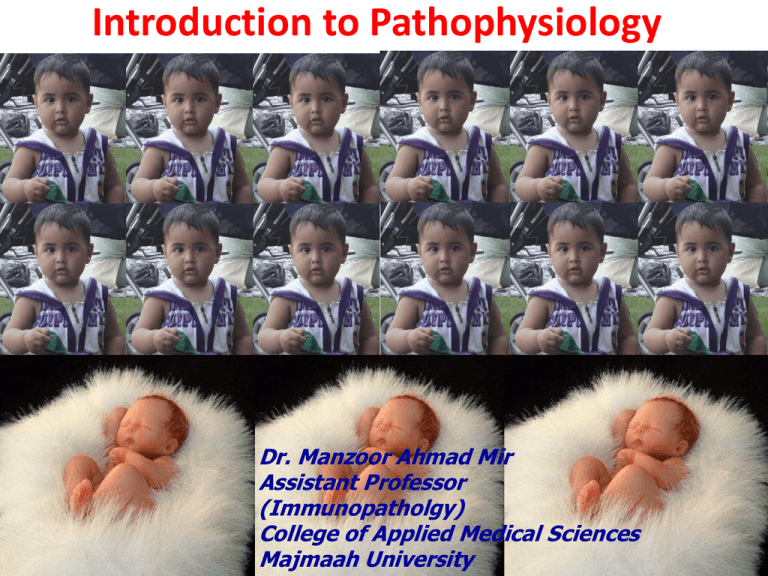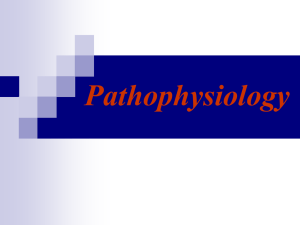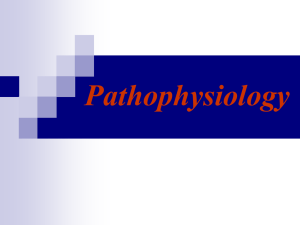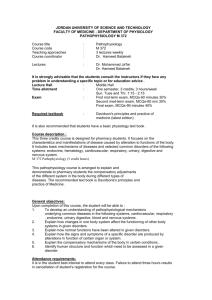Introduction to Pathophysiology
advertisement

Introduction to Pathophysiology Dr. Manzoor Ahmad Mir Assistant Professor (Immunopatholgy) College of Applied Medical Sciences Majmaah University Thought for Every One If you succeed in cheating someone, Don't think that the person is a fool... Just realize that the person Trusted you much more than you deserved! Don’t be over smart and think that some one may be more smart than you as he has left the job many years before which you are trying to learn now. Bone Teeth Abdominal Kidney Liver Brain „House of Medicine“ Neurology Gynekology and Obtetrics Surgery Internal medicine Ceiling plate PATHOPHYSIOLOGY Pathology Pharmacology walls Microbiology PHYSIOLOGY Base plate Anat Biol Histol Bioch Foundations Chem Biophys What the pathophysiology is • Pathophysiologia, ae, f. gr. pathos = disease, pain, suffering Pathophysiology Involves the study of function that results from disease processes. Physiology Life Pathophysiology Logic Healthy Study Diseased Pathophysiology - definitions Pathophysiology is a biomedical science on the mechanisms related to development and elimination of pathological processes and diseases Pathophysiology is a biomedical science dealing with functional changes in diseased organism. It studies disordered or altered functions - the physiologic mechanisms altered by disease in the living organism In clinical setting, pathologists, histologists and cytotechnologist study tissues and cells to establish the cause of a disease. Physicians use that information to form a treatment plan. • Why pathophysiology is important for medical students and physicians 1. It helps them to find answers to important questions related to disease processes: a) What is the cause/causes of the disease, and why the disease is developing b) What are the mechanisms responsible for disease onset, progression, and recovery c) What are the mechanisms responsible for development of symptoms and signs of disease 2. If doctors are able to understand the causes and mechanisms of the disease, then they are able to find the way how to influence them rationally Introduction to Pathophysiology – Sickness The physical and/or mental state of being “unwell” Can be due to emotions, background, inheritance self image, presence or absence of psychiatric problems, etc. – Health Well being state indicating normality of body, mind and spirit. Origin in health cells in tissues and organs – Sign Observable “objective” or measurable physical manifestations of disease(s) or disorder(s) A sign is an indication of some fact or quality; and a medical sign is an objective indication of some medical fact or quality that is detected by a physician during a physical examination of a patient Introduction to Pathophysiology – Symptom “Subjective” evidence of a disease or disorder A symptom is a departure from normal function or feeling which is noticed by a patient, indicating the presence of disease or abnormality. A symptom is subjective, observed by the patient, and not measured – Diagnosis Attachment of a specific name to a specific disease or disorder Summation of signs, symptoms, tissue changes, chemistry, physiology or function changes unique to that disease or disorder Introduction to Pathophysiology – Prognosis Making a prediction of the outcome of a disease or disorder – Therapy Treatment of a disease or disorder Several components –Supportive – lenses –Restorative – VT –Physical agents – laser –Chemical – medications –Surgical Introduction to Pathophysiology – Etiology The “cause of” a disease or disorder – Pathogenesis Underlying mechanisms resulting in the signs and symptoms of the patient – Morphology Gross or microscopic appearance of cells and tissues For a disease or disorder to become manifested clinically, there first must be a dysfunction of a significant number of cells in an organ or tissue Pathophysiology • ...the physiologic basis of disease Disease Any disturbance of structure or function Etiology • ...cause of a disease Incidence • In what populations does the disease occur? • What percentage or percentages? Prognosis • …the predicted probably outcome of a disease. Pathogenesis “sequence of events from the initial stimulus to the ultimate expression of the disease” Diagnosis • ...determination of nature & cause of a disease • Evaluates: – History plays a major role in diagnosis – Signs & symptoms History includes: • • • • • History of current illness Past medical history Family history Social history Review of systems Diagnostic tests & procedures • • • • • • • • • Clinical laboratory tests Tests of electrical activity Radioisotope studies Endoscopy Ultrasound X-ray CT Scan MRI Cytology/histology Treatment - Interventions • Drugs – Which drugs or groups of drugs? • What do they do – why are they used? • Surgery – Which procedures • Purpose • Brief description • Other treatments – Example: radiation therapy • Pathologies may involve Any level or multiple levels All disease occurs because of cell injury Either because of the injury itself or the repair process that follows Causes of Cell Injury • • • • • • • • • Hypoxia Direct physical action Ionizing radiation Toxic molecular injury Microbes Inflammatory & immune reactions Nutritional imbalances Genetic defects Aging Biologic Aging • Apoptosis – Programmed cell death or natural cell death • Necrosis – Death caused by disease or induced cell death • As cells age, functioning decreases • Genetically, telomeres influence cell aging Thank you




